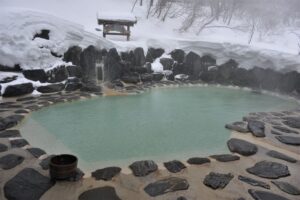
Both the Hot Spring Reports and Inn Reports provide information about water so travelers can make informed decisions about which onsen hot springs and ryokan traditional Japanese inns to visit.
Several factors determine the designation and categorization of a hot spring in Japan. Implemented in 1948, the Onsen Law specifies the conditions necessary to qualify as a hot spring. But what does this mean in practical terms? Let’s find out.
Following are several categories indicated in Hot Spring Reports and Inn Reports on Onsen Adventures that provide insights into the source water quality, temperature, quantity and more, as well as their effect on the types and number of baths at an inn.
Lead photo: One of three outdoor baths at Hige no Ie inn at Takakyu Onsen that features blue-tinged milky-white water
Source water temp
The temperature(s) listed is for the hot spring source(s). Note that the figure does not indicate the temperature of the bathwater. Most baths are maintained at around 40 C to 43 C (104 F to 109 F) depending on the season, altitude and other factors. Publicly posting this number is mandatory under the Onsen Law.
Flow rate
This number represents how much water is flowing from the hot spring source in liters per minute. Publicly posting this figure is not mandatory under the Onsen Law, and many establishments do not display it. One reason why is that water flows fluctuate for various reasons, including the amount of rainfall in a given year.
In general, facilities that display this information are either catering to onsen enthusiasts or they have access to a large amount of water. Greater water flows sustain more baths.
Hot spring type

Hot spring water must contain a minimum amount of one or more of 18 specified minerals such as sulfur and sodium bicarbonate, commonly known as baking soda. Publicly displaying the components and their amounts is mandatory under the Onsen Law.
Heat added
Hot spring water is sometimes heated to make bathwater temperatures comfortable. Most bathwater at hot spring facilities is around 40 C to 43 C (104 F to 109 F). The Onsen Law stipulates that hot spring water temperatures at the source are a minimum of 25 C (77 F).
Water added
Groundwater is sometimes added to hot spring water, mainly because the source temperature is too hot. However, doing so dilutes the hot spring water, so many establishments avoid this or find ways to cool the water naturally. ♨
Questions?
Onsen Adventures can help you find the answer


